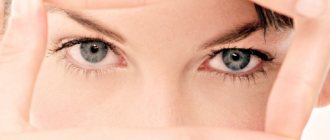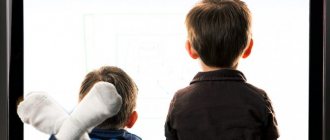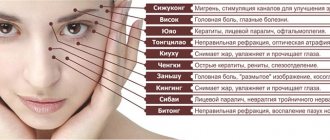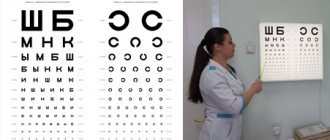Why does school start at age 7?
Not all parents know why children are taken to school at the age of seven. The fact is that it is by this time that the child begins to form abstract thinking. Without it, it is impossible to master the rules of grammar and arithmetic. At the same time, it is by the age of seven that the refraction of his eyes becomes emmetropic. This means that a student will be able to read information equally well from a book in front of his eyes and from a board that hangs at a distance from him. By the age of seven, fine motor skills in most children have developed to a sufficient level, and the muscles of the fingers are strengthened - everything is ready for learning writing, drawing and other sciences.
Why do schoolchildren have decreased vision?
School age is considered a period when eye strain increases sharply: children spend a lot of time indoors with artificial lighting reading and writing. As a result, the eye muscles are constantly tuned to work close, rarely change focus and hardly relax. In addition to this, many schoolchildren sit in front of the TV or computer for too long. As studies conducted by specialists from the National Scientific and Practical Center for Children's Health of the Ministry of Health of the Russian Federation have shown, by the third grade, 49% of modern children's vision is deteriorating, although in the last decade such problems were observed only in every fourth third-grader. The causes of visual impairment vary, but experts mostly blame electronic devices that play too active a role in a student’s daily life.
The sooner a child’s vision problems are identified, the easier it will be to cope with them.
We list the main types of visual impairment in children and their causes:
Myopia (or myopia, from the Greek “myo” - “squinting” and “opsis” - “sight”). Difficulty in visual perception of distant objects. Currently, this visual impairment is becoming an epidemic, experts stated this at the forum “The Health of the Nation is the Basis of Russia’s Prosperity,” held at the end of May this year in Moscow. According to data presented at the forum, in Russia 6–8% of primary schoolchildren suffer from myopia, and among older schoolchildren the incidence of myopia increases to 25–30%. Acquired myopia is a consequence of excessive visual stress at close range and uncontrolled use of electronic devices by children.
Farsightedness is difficulty in perceiving both close and far objects. With this visual pathology, a child may complain of eye fatigue when reading, experience burning eyes and even headaches. These symptoms may worsen with intense visual stress.
Astigmatism is a disorder in the shape of the lens, cornea, or eye, resulting in loss of the ability to see clearly. With astigmatism, objects appear blurry or slightly curved; instead of a dot, the child may see a line or even an oval. Most often, astigmatism in children is congenital. Acquired astigmatism can be a consequence of previous eye injuries, subluxation of the lens, or pathology of the dental system, causing deformation of the walls of the orbit. If astigmatism is not treated, the child may develop strabismus and “lazy eye syndrome,” which is manifested by severe vision loss that cannot be corrected by glasses.
Amblyopia (“lazy eye”) is a decrease in visual acuity in one eye. With amblyopia, the child’s eyes see too different pictures and the brain cannot combine them into one volumetric one, as a result of which the work of one eye is simply suppressed. The most common causes of amblyopia are astigmatism, farsightedness, strabismus, and congenital cataracts.
Oculomotor disorders . One of the most common - strabismus - is not only congenital, but also acquired as a result of injury, neurological or infectious diseases. The opinion that strabismus will go away on its own is wrong; this pathology requires mandatory and timely treatment.
How to understand that a child has poor eyesight?
There are many indirect signs of changes in refraction. You can talk about them if the child:
- sits too close to the screen or holds a book in front of his nose while reading;
- runs his finger along the line he is reading, or often loses the place where he read;
- often tilts his head to take a closer look at the object;
- closes one eye while reading or watching TV;
- closes eyes in bright light;
- often rubs eyes;
- complains of headaches or eye strain.
What should a child's workplace be like?
Make your child's workplace comfortable. Supervise your student while he is doing his homework. Teach him not to slouch, carefully adjust the height of the table and chair to the child’s height. One of the most important points is the lighting of the room. To improve the flow of natural light into the room, clean the windows in the nursery regularly. Make sure artificial lighting is bright enough. When preparing homework, turn on the overhead light and desk lamp. For right-handed people it should be placed on the left, for left-handed people it should be on the right. The shade of a table lamp should not be transparent, and the power of the light bulb should be 75-100 watts. Teach your child to keep textbooks at a distance of at least 40 cm from his eyes. This habit will help you avoid problems with myopia in the future. A child’s work on a computer should be given special attention.
What is a screening examination with an ophthalmologist?
Screening examinations are traditionally carried out in third, ninth and eleventh grades. The doctor’s task is to identify patients with ophthalmological problems and those who are at risk for a number of parameters.
It is worth noting that screening does not replace a full examination by an ophthalmologist. Therefore, if you care about your child's vision, be sure to visit the eye doctor at least twice a year. A problem identified in a timely manner is much easier to resolve than a neglected situation. If a child already has vision problems and wears glasses or contact lenses, an ophthalmologist should be visited once a year. This is due to the fact that as the child grows, the size of his eyes changes. Therefore, at school age, glasses have to be changed quite often.
There are no magic drops
And one more important point: now there are many so-called devices that treat myopia, farsightedness, and astigmatism. It is important to understand that there is no one universal device that can restore a child’s vision. There are no such magic drops or, especially, vitamins for the eyes. A positive result in the treatment of eye pathology in a child can only be achieved through complex treatment, which includes various techniques to increase visual acuity, improve microcirculation of intraocular structures and tissue nutrition. And treatment should not be carried out at home, but only in a specialized children's eye clinic under the supervision of a pediatric ophthalmologist.
How to preserve a child's vision? Advice from Dr. Aznauryan :
- Measure your child's visual load. Be sure to take fifteen-minute breaks during classes, alternate classes with games in the fresh air.
- The distance between the eyes and objects of visual work (books, computer screen) must be at least 40 cm and strictly fixed. If this distance changes all the time, the child’s eyes are in constant tension, which can provoke the development of spasm of the muscle that is responsible for focusing (ciliary muscle), and, as a result, the development of myopia. It is for this reason that it is extremely harmful to read while lying down or in transport.
- By the way, deterioration of vision can also provoke curvature in the cervical spine. Be sure to monitor your child's correct posture.
- Spend more time outdoors with your child. Provide him with proper nutrition with plenty of fresh vegetables, fruits and berries. This is beneficial for the whole body!
- Regularly show your child to a pediatric ophthalmologist, even if he has no complaints. Some pathologies can develop without symptoms.
- If an eye pathology is detected, do not despair and begin treatment as early as possible. Today, modern medicine allows us to treat diseases that were recently considered (and in some places are still considered) incurable. And in many cases, your child will be able to look at the world with clear eyes without glasses or contacts!
“All children need glasses.” An ophthalmologist on how to protect a child’s vision Read more
Vision testing in children
The eyes of babies are checked for the first time in the maternity hospital. An ophthalmologist visually examines a small patient; no medical devices are used. Such diagnostics make it possible to identify serious abnormalities in the functioning of the visual organ: glaucoma, cataracts, etc. With such an examination, it is almost impossible to determine congenital anomalies.
| Planned visits to the ophthalmologist should take place at one, three months, six months and a year. During these visits, the doctor will be able to detect ophthalmic diseases (if any). |
Parents themselves can identify abnormalities in the functioning of the organ of vision. It is enough to carefully observe the baby; if by the age of five months he cannot focus his eyes on a toy and does not recognize his own faces, visit the doctor unscheduled.
Also, the Orlova table is widely used to assess visual acuity in children. There are no numbers and letters on it that a small child cannot distinguish, but various pictures are printed on it. For schoolchildren, they use Sivtsev’s table, which depicts the letters of the Russian alphabet, for testing.
Conclusion
Why does a child's vision deteriorate? An ophthalmologist will be able to answer this question after conducting a series of diagnostic procedures. If you notice that your baby has problems with his vision, you don’t need to immediately put glasses or contacts on him in a panic. Try to restore health to your eyes with proper nutrition and don’t let your children spend a lot of time on gadgets; let them take a walk outside.
After watching the video, you will find out why a teenager’s vision declines
Return to contents
Bans that are good for the eyes
You can't read while lying down. Explain to your child that in this position the eyes will become very tired. You also need to establish a ban on playing games on consoles or tablets while driving. The result of shaking is a constant change in the distance from the device to the eyes. Thus, vision does not have time to adapt, and because of this, there is too much load on this analyzer. All young children have farsighted vision, and over time it approaches normal vision, which is equal to “1”. That is why it is not recommended to sit children under 3 years old in front of the TV; it is better to come up with other entertainment for the child. Further, the limit for watching TV shows and working on the computer can be increased to 30-40 minutes a day. At an older age, this figure can increase to 3 hours, but the child must observe certain time intervals, 20-30 minutes, after which he needs to give his eyes a rest, or better yet, do special gymnastics.
What to do if your vision suddenly deteriorates
It’s clear why our vision is falling, but what can we do about it?
The first thing you need to do is contact an ophthalmologist, who will diagnose the cause of vision loss and prescribe the necessary procedures and medications to maintain eye health.
There are a huge number of techniques and methods that help restore and maintain eye health at the proper level. For example, various gymnastics for the eyes, which can both treat them and act as a means of preventing vision. A special massage is considered beneficial for blood circulation and normalization of eye pressure.
As you know, preventing a disease is easier than dealing with its consequences. Why don’t many people react in time to the fact that their vision is deteriorating? Some due to laziness, others due to ignorance, but the result is the same - a deplorable state of vision by the age of 40. Therefore, it is so important to monitor not only eye hygiene and exercise, but also take care of your health in general.
We receive the lion's share of information about the world around us through visual perception, so the first question when vision suddenly deteriorates is: “What to do?”
There are two main reasons leading to decreased vision: any disease or conditions of our life that not only worsen eye health, but also provoke the development of a variety of ailments.










